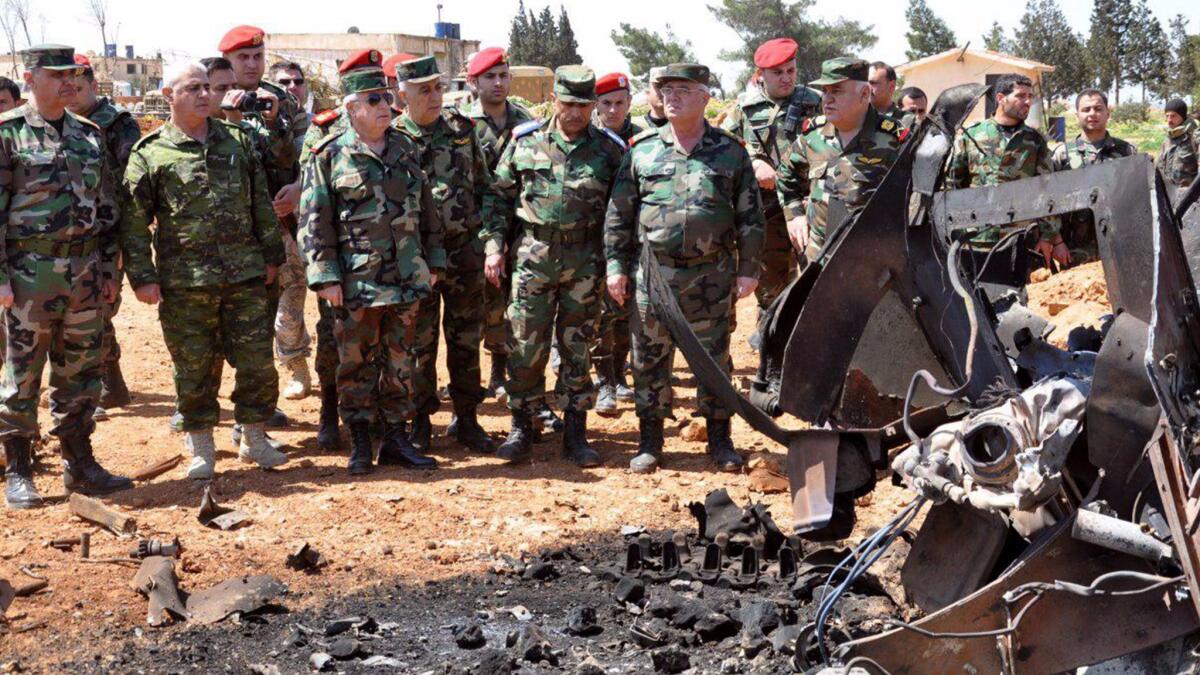Syrian villagers near U.S. missile strike know the sound of battle — but never as horrific as this

- Share via
Reporting from Beirut — It was less than a couple of hours before dawn when Wael Zefa heard a “horrific amount of noise” rumbling through the east Syrian village of Shayrat.
During the six years of civil war ravaging Syria, Zefa has become used to the sounds of mortar shells and rockets. But nothing like this.
“What we heard this morning … their sound was very, very loud,” he said.
Explosions ripped through the morning. The ground shook. Windows broke. Walls cracked.
What Zefa and his neighbors experienced was the pounding of Tomahawk cruise missiles launched by the U.S. to clobber the Syrian government’s Shayrat airfield, less than a mile from the village.
A total of 60 missiles were fired at 4:40 a.m. Friday in response to an apparent chemical weapons attack this week, blamed by the U.S. on the government of Syrian President Bashar Assad, that killed an estimated 70 people in the rebel-held province of Idlib.
Zefa’s house was shaken so severely that a chunk of the roof broke off and smashed to the ground.
“There was no way we could stay at home,” Zefa, 38, said by phone from where he and his family have sought shelter.
Zefa quickly sent his wife and four children to a nearby bunker before running to his roof for a better view. What was unfolding, he would learn later, was a new front in America’s involvement in Syria: After thousands of airstrikes directed at Islamist militants, U.S. missiles for the first time were directly targeting Syrian military assets.

The Pentagon described the strike as a “proportional response to Assad’s heinous act,” possibly involving a nerve agent, directed at the northern town of Khan Sheikhoun.
The strike was intended to “deter the regime from using chemical weapons again,” the Pentagon statement said, adding that the Shayrat airfield had been used to store chemical weapons.
The Pentagon said 59 cruise missiles (one fell in the water) hit “aircraft, hardened aircraft shelters, petroleum and logistical storage, ammunition supply bunkers, air defense systems, and radars,” rendering the military airfield inoperable.
Russian forces had been notified of the strike in advance, and had taken “precautions to minimize risk to Russian or Syrian personnel located at the airfield,” U.S. officials said.
But Syrian state news operator SANA said six soldiers had been killed in the attack. It later reported nine civilians had also been killed, including four children, in the surrounding villages, though there was no way of independently verifying the reports.

Video shows U.S. destroyers Porter and Ross as they launch Tomahawk missiles into Syria. The Pentagon said 59 missiles targeted a Syrian air base.
A grainy nighttime video released on social media Friday depicted the moment of the missiles’ impact. It shows a succession of glowing lights in the distance, then the shaking of the cameraman’s hand as a missile apparently makes thunderous contact.
Mohammad Zefa, a 41-year-old oil ministry employee, had run outside with his family during the strike. When one of the missiles hit an ammunition warehouse, he said, “you stopped knowing where the explosions were coming from.”
“We ran back inside the house. After, we saw a rocket had fallen thirty yards from our house,” he said in a telephone interview. “All the windows broke, here and at my neighbor’s house. Some older houses even had cracked walls.”
A report by Russia24 television from Shayrat airbase showed the strikes’ results. A number of aircraft parked in concrete hangars appeared unscathed, while other parts of the airfield were a jumble of debris and charred metal chunks.
A correspondent with Russia24, Evgeny Poddubnyy, said in an interview on social media that nine hangars had been destroyed, along with six aircraft, as well as a large amount of ordnance. The runway, however, and a number of Russian helicopters and another Syrian aircraft appeared to be undamaged.
The loss of the airbase is a significant one for the government. Built in the 1960s, it had 40 hangars and housed a large number of Assad’s fighters bombers, which often would scramble to attack rebel-held areas near the city of Homs.
For residents of Shayrat and other villages, the airbase was instrumental in keeping at bay Islamic State militants hiding in the eastern desert of Homs.
Now with the base so severely damaged, Mohammad Zefa, a distant cousin of Wael Zefa, expected Islamic State to try to advance to the village.
“Women and children have already started to leave Shayrat to go to Homs city. We’re not afraid of airstrikes. Our fear is the attack from the east,” he said.
For him, Friday’s attack was “proof that the U.S. helps Daesh.” He referred to Islamic State by its Arabic acronym.
When Islamic State first overran the city of Palmyra in 2015, it celebrated its takeover with a theatrical slaughtering of government soldiers. Mohammad Zefa insisted he would fight before suffering the same fate.
“Here we are loyalists to the state to the highest degree,” he said. “It’s an existential battle for us.”
Bulos is a special correspondent.
ALSO
Syria crisis tests Trump’s plan for a new world order
President Trump sees push back from far-right supporters over U.S. airstrike in Syria
U.S. missile strike in Syria dashes hope of improving ties with Russia
More to Read
Sign up for Essential California
The most important California stories and recommendations in your inbox every morning.
You may occasionally receive promotional content from the Los Angeles Times.











